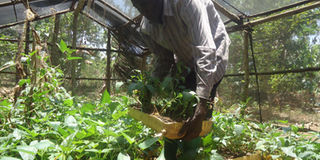How sweet potato tastes is important to breeding

A sweet potato farmer places vines that he multiplies for other farmers in a screen house. End-user preferences are important to consider in selecting and breeding sweet potato varieties. PHOTO BY FRED MUZAALE
Sweet potato breeders have been advised to put the tastes of the consumer first in order to increase its consumption.
This was in remarks made by Dr Ambrose Agona, the director general, National Agricultural Research Organisation (Naro) at the 14th Annual Sweet Potato Breeders’ Meeting, which was held June 2-5, in Mukono.
He said breeders should customise their work according to what the end-user wants and what the market demands.
The meeting was attended by sweet potato breeders from 12 countries including Ghana, Kenya, Ethiopia, Nigeria, Rwanda and Tanzania. There were also scientists from the Genomic Tools for Sweet Potato Improvement Project.
Client tailored
“In Uganda, the Kyebandula type of sweet potato appeals to many but generally, Ugandans like not-so-sweet, hardish sweet potatoes, which have a dry feel. Women prefer straight ones with no curves, which eases peeling while children like them very sweet and soft,” noted Dr Robert Mwanga, from International Potato Centre.
“In our work, we should know what the end users want,” agreed Ernest Baafi, a breeder at the West Africa Centre for Crop Improvement, adding that the ‘client-tailored’ preferences were key to their jobs.
In Ghana, they have identified the main constraints, for instance some clients say they do not want “sweet” sweet potatoes because they eat them with salty sauce, so the breeders have to knock off the sugar.
Potato production
The sweet potato is widely grown in East Africa and it is the third most important food crop in terms of production.
Worldwide, Uganda is second to China in sweet potato production, even if it produces only 2.5 million metric tonnes annually compared to China’s 117 million metric tonnes.
It is a staple food in Uganda, and in light of the devastation caused to the banana by the wilt disease and to cassava by the mosaic, it is bound to be a major source of carbohydrates and income for small scale farmers.
This is through sale of storage roots, vines and processed products in rural and urban markets, and for animal feed mostly pigs, said Dr Agona.
Quality characteristics
Uganda ranks number one, in East Africa, in pork per capita consumption. Sweet potato vines, roots and peels are good pig feeds. It would be a bonus in reduction of the cost of feed.
The meeting also discussed ways in which breeding work can also generate drought-tolerant, virus-resistant, orange fleshed sweet potatoes. This is with beta carotene that combines different quality characteristics with significant improvements in yielding ability.
Mwanga said breeders should focus on virus resistance, which is considered crucial for productivity improvement. This is viral diseases, which are vectored by white flies and aphids, cause yield losses between 50 and 90 per cent especially in the East Africa region.
Boosting yields
The breeders were also looking to redesign the systems to produce varieties in three to four years instead of the current seven to eight years through an accelerated breeding scheme.
Mwanga said sweet potatoes are some of the foods that can be fortified yet many women and children die needlessly due to Vitamin A yet if beta carotene is added they would be avoided. Low storage ability also remains a challenge.
“We should increase the productivity of sweet potatoes focusing on the orange fleshed ones that are naturally bio-fortified, virus resistant and not moist,” said Agona.
He said the average yields are still quite low and the amount of food is not enough to match with population growth.
“Once the breeders know what the end-users want, they will breed towards that,” said Mwanga.
The sweet potato is a high yielder, reduces malnutrition and improves food security.




